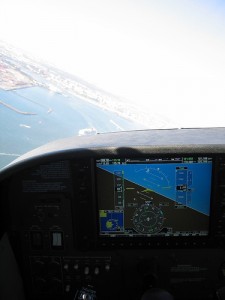Airplane Single Engine Rating Time Requirements
This has been a pretty busy week for me as I am currently in Wilmington, DE at my yearly recurrent training event at Flight Safety. My recurrent training is something I definitely look forward to each year. It is a wonderful opportunity to not only re-learn the things I have forgotten since last year but also a chance to sharpen my procedures and flying skills within the safety confines of a flight simulator. A little plug here…Flight Safety Int’l is a top-notch organization and over the years, I have had nothing but the best experiences with the instructors, administration and staff. They are absolute pros at professional flight training. It is no wonder, they are the leaders in their industry.
Unfortunately, because of my training and my flight schedule, I’ve fallen a little bit behind with some flight training questions here but I just received a question from Andrew that I’d like to answer. Andrew asks:
I have a rotorcraft private and i would like to get my Single engine private. How many hours do i need in single engine to get my rating?
Hi Andrew,
You want to look at 14 CFR 61.109 – Aeronautical experience private pilot.
As a rotorcraft private pilot I’m guessing you already meet the 40 hour requirements, so now all you have to do is
meet the specific time requirements for airplane single engine. These requirements are:
- 3 hours of cross-country flight training in a single-engine airplane;
- 3 hours of night flight training in a single-engine airplane that includes 1) One cross-country flight of over 100 nautical miles total distance; and 2)10 takeoffs and 10 landings to a full stop (with each landing involving a flight in the traffic pattern) at an airport.
- 3 hours of flight training in a single-engine airplane on the control and maneuvering of an airplane solely by reference to instruments
- 3 hours of flight training in preparation for the practical test in a single-engine airplane, which must have been performed within 60 days preceding the date of the test
- 10 hours of solo flight time in a single-engine airplane, consisting of at least 5 hours of solo cross-country time; One solo cross-country flight of at least 150 nautical miles total distance
So it kinds of depends on how you divide up the lessons with your flight instructor, but you know that you’ll need at least 10 hours of solo and probably another 20-25 hours of dual given from an instructor. You’ll use this time with the instructor to prepare you for your solo, cross country training and then of course the checkride test preparation. I’d budget at least 35 hours of flight training for your private pilot single-engine add-on.
Again, reference 61.109 for more information and here is the link to that CFR:
You also might want to reference the private pilot PTS:
http://www.faa.gov/training_testing/testing/airmen/test_standards/pilot/media/FAA-S-8081-14A.pdf
Look on page 26 of this pdf. On that page, you’ll see an “Additional Rating Task Table.” That task table is useful for knowing what specific tasks you’ll have to complete on your checkride given your current ratings and certificates.
Thanks for stopping by the site and let me know I can be of any further help.
Fly Safe.



John Shelton on Jun 21, 2009
I have a private pilot certificate with SEL but am not current with a BFR. I am training for a helicopter add-on rating and am wondering if I first need to do a fixed-wing BFR to be current before I can take the FAA check-ride for the rotorcraft add-on rating.
Thanks in advance,
John
Tom Bevers on Jul 04, 2009
You have been training for a PPL, and at the conclusion you are ready to take the oral and practical. The oral is passed, and you are getting ready to fly at your local, single runway airport when the weather suddenly turns into virgo 2. Squalls are on the nearby hills where the practice area is; the examiner says”its your decision if we go or we defer the rest of the test.” The student says we can’t go with the conditions that are building since there is a cc to more than 25 miles from the airport.
Three days later the examiner calls and says to bring the airplane to his location which is a multiple runway, busy metropolitan airport with lots of tricky pattern and noise restrictions, and the student has never been to the airport. The student tells the examiner that the required endorsement for this airport is not in the logbook. The examiner says” its only ten miles away meet me at noon tomorrow.” The student gets his instructor to fly to the airport with him, and he gives the endorsement with plenty of concern and advice. After flying back to home airport, dropping the instructor off the student returns, picks up the examiner; by this time the adrenalin is peaking, and the first takeoff is short field-no problem except the student didn’t retract the ten degrees of flap on goaround. At pattern altitude the tower calls for an early crosswind, and shortly on downwind calls for a 360 which didn’t cause any problems-speed and altitude were ok. Then on final the tower sidesteps the plane to the parallel runway. Landing was okay and go around for another landing was initiated.
The examiner asked for a normal landing and the student had over two hundred “normal” landings as characterized by the instructor; landed with no flaps.
The examiner took the controls and the test was ended. The examiner explained that a normal landing is with flaps. He proceded to land the plane with full flaps with both main wheels to the right of the centerline. The student had never made that kind of touchdown because his instructor wouldn’t accept it.
Any comment on this scenario may be helpful to someone getting ready for the practical.